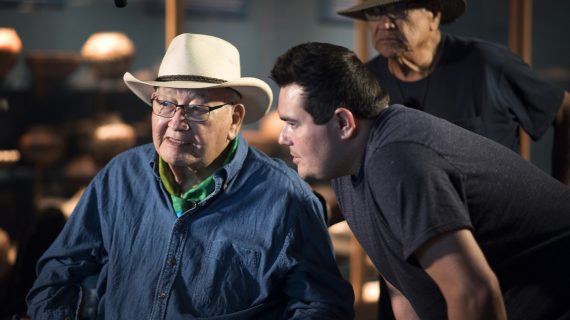[Marge Murray, U.W. Health]
My name is Marge Murray and I work for U.W. Health, and I thank you all for coming out for our Better With Age program. It is my pleasure to introduce Dr. Nicole Pulia. Nicole is a brand-new assistant professor in the Division of Geriatrics at U.W.’s School of Medicine and Public Health. She’s a PhD speech therapist who is working in the area of swallow as we age. That’s her research. And she is here to talk about the changes that happen as you swallow – as you swallow as you age. Here we go, okay.
[Nicole Pulia, Assistant Professor, University of Wisconsin School of Medicine and Public Health]
Thank you. Thank you so much, Marge.
Thank you all for being here, and for the invitation to present today. As – as Marge mentioned, I am a new assistant professor at the University, just getting my – my research program up and going. And my particular interest is the development of new treatments for swallowing disorders for older adults. So, this is really the focus of my – my research.
Today I’ll provide you with an overview of some of the specifics of swallowing, what goes into the process of swallowing. It’s something that we do 600 to 1,000 times a day without even thinking about it, right? And so, there are actually a lot of factors that we have to consider to have a safe swallow. And I’ll explain what that means. And then, I’ll talk a little bit about the role of a speech language pathologist in the evaluation and treatment of swallowing. We have a lot of really great options that we can offer if you do have some difficulty swallowing, and also some things we can recommend that will be preventative for your swallowing as well.
So, I just wanted to start off with this –
[slide featuring eight photos (circular from top left) a family of eight sitting around a table al fresco eating lunch; a couple dining seaside with a friend; an Oriental family of six sitting around a round table having dinner; and elderly man in a fedora about to grab a large bit of an apple; two little kids drinking juice out of straws at a restaurant; an elderly lady with her lunch on a tray at a nursing home; a Black family of four eating lunch at a diner; and a group of three coworkers having lunch in a break room. The slide also contains the following statement – Eating is a biopsychosocial activity that is a key element of healthy life]
– this point, that eating is a biopsychosocial activity, right? You can see all these pictures. And if you really think about all of our social activities, so many of them happen around food, right? I’ll meet you for a drink, Let’s have lunch, Well meet for dinner, Come over for a meal. So, so much of our interaction with other people, and I think so much of our quality of life, is around food. So, we need to be able to do that-
[slide featuring the definition of two words that are in red – Swallowing – to move material from the mouth through the esophagus into the stomach by a series of muscular actions; and Dysphagia – a swallowing disorder characterized by difficulty moving food, liquid, secretions, or medications]
– swallow, in a safe manner.
So, the term swallow means to move material from the mouth through the esophagus into the stomach through a series of muscular actions. In contrast, the term dysphagia refers to a swallowing disorder that’s characterized by difficulty moving food, liquid, secretions, and medications. And I think at least in our field, we focused a lot on understanding what happens when you swallow liquid and food, and a little bit less about how this impacts your ability to swallow your saliva throughout the day and manage your secretions well. And also, how it affects your ability to take medications. And so, those are some areas that are important to think about and for our research –
[new slide titled – Neurophysiology – with the statement that – Swallowing is a complex act requiring 1) Synchronization of 40 muscle pairs, 2) Integration of 6 cranial nerves, and 3) Domination of respiratory system. Additionally, to the right of the numbered list are four illustrations – one labelled a – that shows the areas of the tongue and roof of the mouth involved in swallowing; one labelled b – that is a cross-section of a human head showing all the nerves and muscle pairs involved in swallowing; one labelled c – that is a closer cross-section of the jaw and nasal areas involved in swallowing]
– to move forward and answering some of those questions.
So, as I mentioned, swallowing is a complex act that requires synchronization of 40 different muscle pairs, the integration of six different cranial nerves, nerves up in the head-neck region. And then also we say domination of the respiratory system. What we mean is that when you swallow, you cannot also breathe. Because if you were to try to take a breath at the moment you’re swallowing, you’ll breathe whatever you’re swallowing down into your lungs, which we don’t want to happen. So, you have to be able to have the respiratory ability to stop your breathing, swallow. And if you’re having difficulty breathing, then swallowing can be affected.
[new slide titled – Patterned Response, Large scale distributed swallowing neural network – featuring an illustrated diagram from the brain to the stomach and showing all the nerves that are involved in the act of swallowing. On the left-hand side of the slide are the words – supratentorial input and on the right-hand side of the slide are the words – volitional aspects. At the bottom of the slide is the statement that swallowing is not a reflex in the traditional sense]
In the past, we used to think of swallowing as sort of reflex response. So, you’d put food and liquid into your mouth, you take it to the back of your oral cavity, and boom, a swallow happens. It’s like the reflex in your knee that the doctor, you know, checks out at your – at your visit. We now know that’s not actually the case at all. It’s a very complicated patterned response that involves multiple levels of the brain, the brain stem, the cortex, and it involves a really precise coordination. So luckily –
[Nicole Pulia, on-camera]
– we’ve had some really good imaging studies over the past 10 years that have given us some more information about what’s all involved in a swallow.
So, just to give you an overview of the – the normal swallowing process. So, we tend to define swallowing by four phases. I’ll just make the point that these phases are not discrete. So, you can be in one phase and another at the same time. And we’ll talk about, it – it – I’m sure you’ve experienced that yourselves.
[slide titled – Normal Swallowing Process – with the following bulleted list after the heading – Stages during a swallow (not discrete): Oral preparatory phase; Oral phase; Pharyngeal Phase; Esophageal phase. The slide also contains two illustrations – on the right-hand side of the slide is a colored illustrated cross-section of the mouth, nasal and neck area with the areas of the nasal and oral cavities labelled (tongue, lips, teeth, etc.) as well as those areas of the neck labelled (soft palate, uvula, esophagus, etc.). The second illustration is black and white as is below the bullet list and features another illustrated cross-section of the mouth, nasal and neck areas and pointing out with arrows that the first act of swallowing (in the tongue area) is horizontal, while the second act of swallowing (involving the soft palate, Hyoid, Vocal chords and UES) is vertical]
The oral preparatory phase refers to the time when you’re preparing the food to be swallowed. So, it’s mostly mastication or chewing, right? You have the food in your mouth, you need to chew it up, move it with your tongue between your teeth, and prepare it so that you can swallow it. Saliva is a big part of that process. There’s an enzyme in saliva called amylase that starts to break down your food. So, the digestive process actually happens already starting in your mouth, before it even – before food even makes it to your stomach, you’re already breaking it down.
The oral phase is when you’re done preparing the food. You take your tongue, you move it into the sides of your mouth, you gather everything together into a ball in the middle of your oral cavity, you use your tongue to move it back into your throat. That’s the oral phase. And so, it’s a sequence of muscular contractions of the tongue up against the roof of the mouth that move the food back.
The pharyngeal phase has quite a few events in it, and I’ll just point out here, this little laser pointer, I can kind of show you. [uses laser pointer to point to the tongue in the colored cross-section diagram which is much larger than one would think] So actually, this structure here, that’s all the tongue. I don’t think people realize how big your tongue actually is. There’s a portion of your tongue that’s back in your throat called the Base of Tongue, and then there’s a portion that’s in your mouth called the Oral Tongue, which is what you can more voluntarily control when you speak.
So, the oral phase is where we take the food and liquid from here [uses laser pointer in the cross-section illustration to move it from the mouth area back towards the soft palate area] we move it back here. Once the food and liquid reaches the back of the oral cavity, there are some sense – sensory receptors. So, if you ever looked in someone’s mouth, you’ll see there’s like two little pillars, right? When they open up, you can see these kind of structures. In those structures are sensory receptors that tell the brain, Hey, there’s something coming into the throat, and we need to go through this series of –
[Nicole Pulia, on-camera]
– actions to protect the airway. So, in the way that humans, you know, were unique in that we can use one structure in our body to talk, to breathe, and to swallow. And that’s wonderful, it’s very efficient. But if something goes awry, it can be problematic.
So, once the – the food or liquid gets to the back of the throat, we trigger the swallowing response, is – is what we call it. So, the series of actions that happen during that pharyngeal phase, the part of your tongue here in your throat comes back to contact the back of your throat and put a nice pressure on the food that you’re swallowing to help to push it down through your throat. We also have to close off our voice box, which is in the front of our throat, or also called your larynx, inside your voice box you have vocal folds and when you take a breath into your lungs you let the air out and it vibrates your vocal folds, and that’s what makes sound. When you swallow, you have to close off your voice box, so that nothing can go down into your voice box from your voice box it will fall into your lungs, down through your trachea and your windpipe into your lungs. So, we have to close that off. So, there are some muscles that connect to the voice box that move it up and forward and close it off. And there’s a little structure here called the epiglottis that will come over, invert and cover –
[return to the slide titled – Normal Swallowing Process – described above]
– your voice box.
There are some muscles [uses laser pointer to point out the muscles in the throat] in the throat, and we call the pharynx, the throat, that contract sequentially to move the food and liquid down, and then the top of your esophagus is right here [uses laser pointer to point out the top of the esophagus on the colored cross-section] , the esophagus is the tube that goes down to the stomach, and at the top of that we have a sphincter called the upper esophageal sphincter.
So, when you’re sitting here at rest, that sphincter is closed, and the reason it’s closed is because if it was open, you’d have lots of acid coming back up from your stomach and into your throat. So, when you swallow, you have to relax that sphincter to let the food and liquid into the esophagus and then after that happens it closes back up again right away.
So, all of those events constitute what we call the pharyngeal phase, and then the esophageal phase is when the food and liquid has entered the esophagus and moves its way down into the stomach. And I won’t talk much about that today because it’s not within my – my scope of practice to evaluate and treat –
[Nicole Pulia, on-camera]
– esophageal issues, that would be your gastroenterologist that you would need to talk to about that, but we work closely with a gastroenterologist at the U.W. and the V.A. to do combined evaluations quite a bit.
So, when something goes wrong during the swallow, you can have food or liquid enter the airway. In this image here on –
[slide titled – Airway Invasion Levels – featuring a colored cross-section of the mouth and throat area and a picture of an x-ray of someones throat. The colored cross-section is titled – Penetration – and shows a liquid that has entered the vocal cords (indicated in the cross-section by a blue circle) and the x-ray is of liquid that has passed through the vocal folds (indicated on the x-ray with a red circle) and is titled – Aspiration]
– the left you can see that [indicating the blue circle with the laser pointer], so this here is the voice box [indicating the voice box in the cross-section with the laser pointer], this line, that’s your vocal folds, [indicating vocal folds with the laser pointer] here the liquid that’s being swallowed a little bit snuck in the top of the larynx, up in the – we call the vestibule – that’s called penetration. If that material moves down through the vestibule – vestibule below the true vocal folds, and you can see that [indicating a line on the x-ray that is the vocal folds with the laser pointer] this line here is an X-ray showing liquid that’s moved down below the vocal folds, that’s called aspiration. And I don’t know if any of you have heard that term before, aspiration, but if aspiration happens repeatedly over time, you’re just getting more and more material into your lungs, and if that material sits there, it can develop infection and turn into pneumonia, so that’s what we’re concerned about.
So, when we’re watching – and I’ll describe your swallow studies that we do – we’re really looking to make sure that there’s no aspiration. Penetration we’re not as worried about but if the material gets in here [indicating the vocal folds in the cross-section with the laser pointer] and it doesn’t come out, it could turn into aspiration, so we have to watch –
[new slide titled – Who is at risk? – and having the following bulleted list – Dysphagia is not a disease; Results from one or more underlying diseases or conditions; Incidence and prevalence related to etiology. Under the bulleted list is a list of conditions that could lead to dysphagia – in Infants, prematurity and syndromes, in Children, cerebral palsy and head injuries, and in Adults, aging Baby Boomers. The slide also has a small photo and a small illustration in the lower corners – the photo (left) is of an elderly woman drinking coffee at a nursing home, and the illustration (right) is of a mother and baby having a visit with a doctor]
– for that too.
So, in terms of who’s at risk for dysphagia, it’s important to remember that dysphagia is not a disease in itself, it’s the result of lots of underlying diseases and conditions. So, I have people ask me all the time, you know, What kind of dis – what kind of patients do you see? And I say, Everyone. [laughs] Because you can have lots of different things that can lead to dysphagia. It can happen in infants that are born premature, that have different types of syndromes, children with cerebral palsy, or who suffered a head injury, and then as we age, we also are at risk for developing dysphagia and I’ll talk –
[new slide titled – Adult Dysphagia Populations – and noting that 18 million adults with dysphagia in 2010. Additionally, there is the following bulleted list next to a photo of a crowd of people at a large gathering – Neurogenic; Immunologic; Iatrogenic; Obstructive; Psychiatric; and General deconditioning]
– more about that.
There are estimated to be about 18 million adults in the U.S. with dysphagia. There are a variety of different causes. Some of the neurogenic causes, of those the most common is stroke. Immunologic causes would include Sjgren’s Syndrome, scleroderma, polymyositis. Some of the iatrogenic causes could be medication; so if you’re taking a medication that causes dry mouth you might experience some difficulty swallowing. If you take something that depresses your central nervous system, you can also have some difficulty swallowing. People who’ve been diagnosed with head and neck cancer, cancer of the mouth or the throat, undergo chemotherapy and radiation as their treatment to this region and so they can also develop dysphagia.
Some obstructive causes could be as I just mentioned a tumor, little bony outgrowths on your spine. Sometimes you can develop a pocket in your – top of your esophagus called a diverticula. So, lots of different ways –
[Nicole Pulia, on-camera]
– that things can obstruct the flow of food and liquid through your throat.
Psychiatric causes, the main being dementia, but some of the medications for psychiatric conditions like depression can depress your central nervous system and cause some issues. And then also just general deconditioning from illness. So, if you’ve been admitted to the hospital and you haven’t been up and moving you can experience some deconditioning that can affect the muscles of your head and neck as well.
We know that this is an increasing –
[slide titled – An Increasing Problem – featuring an illustration of an elderly man in a green vest coughing in the upper right and the following bullet – By the year 2030, the number of individuals over the age of 65 years will greatly increase and account for approximately 19% of the population]
– problem, by the year 2030 the number of individuals over 65 will greatly increase and account for about 19% of the population –
[the slide animates on the next bullet point – Currently, 22-40% of adults over 50 years of age suffer from swallowing disorders (dysphagia)]
– and it’s estimated right now that currently 22 to 40% of adults over 50 have some type of swallowing disorder and that’s a pretty wide range. Our prevalence studies are not excellent, so we need –
[new slide titled – Without effective treatment, dysphagia can lead to – and under the title is the following bulleted list – mortality; pneumonia (pulmonary complications); malnutrition; dehydration; lower rehabilitation potential; lower quality of life; higher length of hospital stay]
– more of those.
Without effective treatment dysphagia can lead to, obviously worst case, mortality, but pneumonia as I’ve already mentioned, also malnutrition, dehydration, if you can’t get food and liquid down effectively and safely, you’re gonna be malnourished. Then those can also lead to decreased potential for rehabilitation after a hospital stay. Decreased quality of life and also increase the length of time that people are in the hospital.
[new slide titled – Pulmonary Health Critical – featuring three color illustrations under the heading Pneumonia. The first illustration is a cross-section of the human breathing system with arrows showing the path of air from the nasal area and mouth down the windpipe and into the lungs with arrows showing air flowing into the bronchia. The second illustration is of a normal bronchium with air flowing through it and into and out of it. The second illustration is of a bronchium that has been contaminated with mucus and food particles that is pneumatic]
We –
[the slide animates on the following bullet point under the heading Pneumonia – Most common cause of infectious death in U.S. among persons over 65 years of age]
– know that pneumonia is the most common cause of infectious death in the U.S. for people over 65 –
[the slide animates on the second bullet point under the Pneumonia heading – 3rd leading cause of death over 80 years of age]
– and it’s the third leading cause of death for those over 80. So, this is a – is a big issue and we’re not – I think we’re still in the early phases of understanding exactly what the role of dysphagia is in that, but we have had some studies, there’s one out of Spain, recently over 700 patients and they did show dysphagia to be an independent predictor of hospital readmission due to pneumonia. –
[Nicole Pulia, on-camera]
– So, we know it’s playing a big part in these – in these episodes of pneumonia.
So, as you get older there are changes that naturally happen in your swallow and they’re not abnormal, they’re normal age-related changes, we term them presbyphagia. So, how does swallowing change as you get older?
[slide titled – How does swallowing change? – featuring two photos and the heading Anatomy. The first photo at the bottom left is of a babys face on the left and an old mans face on the right. The second photo is an x-ray of a persons neck with the persons Hyoid bone in the neck highlighted with a yellow rounded, dashed box. Under the heading Anatomy is the following bullet point – Hardening of laryngeal cartilages and the hyoid bone]
Well, some of the cartilages in your throat, the cartilages of the larynx or voice box can harden, and there’s also a bone right up under your chin called your hyoid bone that lifts – helps to lift your voice box up and close it during the swallow, that can get harder too and make it difficult – more difficult to move that bone during –
[the slide animates on the next bullet point under the heading Anatomy – From age 70 and beyond, larynx is lower in neck]
– the swallow.
From the age 70 and beyond our voice box lowers in our neck, which isn’t necessarily an issue, but it does sort of link – increase the space in the throat for things to enter into the voice box to put you more at risk.
[the slide animates on the final bullet point under the heading Anatomy – Increase incidence of cervical arthritis – may impinge on pharyngeal wall]
And then there’s also an increased incidence of cervical arthritis in the cervical spine that can affect – push on the pharyngeal wall in the throat and affect the swallow.
[new slide still under the title – How does swallowing change? – featuring two line graphs and a bulleted list under the heading – Physiology with the following bullet points – Timing: Healthy swallow occurs more slowly; Structural movement is reduced. The two line graphs have time in seconds on the x-axis and anterior hyoid movement on the left graph and vertical hyoid movement on the right graph. Both graphs have two lines a piece – one for a young man and one for an old man. The left graph shows a large decrease in anterior hyoid movement over time for the old man compared to the young man. Additionally, the right graph shows the old man having a larger vertical hyoid movement over time compared to the young man]
We also know that swallowing occurs more slowly as we get older and that we don’t have as much movement of the structures in our throat. So, these graphs here on the bottom – remember I described that bone right up under the chin called the hyoid bone – this shows in a group of young participants, younger participants [moves laser pointer along the young persons graph line on the left graph] that they have a lot of movement of their hyoid bone, and then as you get older [uses laser pointer to follow the shallower path of the old mans line on the graph] that movement is less. And if that movement is less, it means that your voice box may not close off as well and you may have more issues opening your esophagus to let food and liquid down into – into your esophagus.
[new slide titled – Penetration occurs more frequently – featuring two bar graphs. Both graphs have Age in Years on the x-axis for two factors – By Swallow (black) and By Person (pink), and both graphs have Percent of Penetration on the y-axis. The top graph is penetration of liquids, and the bottom graph is penetration of solids. Both graphs show large spikes in penetration starting by age group 60-69 and peaking at age 80-89 in the first graph (liquids) and at over 90 in the second graph (solids)]
And then remember I described the term penetration which is where food and liquid just sneaks into the top of the airway. So, we know that that also happens more frequently as we get older so you can see here on this graph this – the black is penetration by swallow and the pink is by person, and you can see those that are up in the higher age ranges are at a greater risk of penetrating liquid into the airway. And then it’s interesting that it drops for the over 90 group but what is actually quite concerning is that penetration of solids is much more common in those over 90. So, you can imagine if you get a little – if you get liquid into your airway a lot over time, it puts you at risk for infection; if you have solid food going into your airway, it can actually block your airway so that you can’t breathe, so that’s why this is so critical to think about –
[new slide titled – Neural activation for swallowing – featuring three bar graphs for the three Brodmann Areas (Primary Sensory Areas, Motor Areas, and V1) with swallowing on the x-axis for two age factors (young[green] and old [yellow]) and percent signaling change on the y-axis. The graphs all show decreased percentage of signal change for all areas for the older subjects compared to the younger subjects]
– as we age.
And then there are some studies that have used functional magnetic resonance imaging, which is a technique to image the brain, and have shown that there – the areas in the brain that are really responsible and important for swallowing are not as highly activated during swallowing as we get older. You can see that here, so the green is the young and the yellow is the old, and these are primary sensory areas [uses laser pointer to indicate the first graph] in the brain that sort of interpret the sensory information that’s coming in and they’re lower activated. And then these are [uses laser pointer to indicate the second graph] areas in the brain that control the motor, like the actual muscle contraction response for swallowing and they’re less activated as well.
[new slide, back to the title – How does swallowing change? – featuring an illustration and a bar graph under the bullet point – Decreased tongue strength and pressure reserve. The illustration is a cross-section of the head and neck area with a blue balloon type structure located between the tongue and the roof of the mouth. The bar graph is labelled Anterior bulb and features four measurements on the x-axis (Isometric, 3ml Liquid, 10ml Liquid, and Seraisolid] for two factors [young (white) and elderly (black)]. On the y-axis is Pressure. The graphs show greater pressure on the anterior bulb from the young compared to the elderly]
We also as I showed you before you can see that the tongue is very big and that it plays a very important role in swallowing. So, in order for us to get that food and liquid from that front of the mouth and into the throat, we need our tongue to be working really well and we need it to be strong. And we also need the part of our tongue in our throat to really create a lot of pressure and push on the food and liquid to get it through our throat. And so, we’ve done some studies in our field using a device you can see it here [indicating the blue balloon shaped structure in the illustration with the laser pointer] it’s this blue bulb called the IOPI, Iowa Oral Performance Instrument. So, it’s a little blue bulb that you put in the mouth, and you have the individual take their tongue and push against the bulb against the roof of their mouth as hard as they possibly can. And then we can tell, we can use that to tell how strong their tongue is.
And so, there’ve been a lot of studies that have looked at this, and you can see –
[the slide animates on a red circle over the top of the Isometric bar graph lines on the graph to indicate where the contrast between young and elderly is the greatest]
– here that the black being older, those pressures that can be produced with the tongue decrease as we get older, but what’s really interesting I think is that pressures you produce with your tongue during swallowing – so, if we just say, Take your tongue, push it up against the roof of your mouth as hard as you can, your pressures will be lower as you get older, but we can also put the bulb in and just say swallow. And we can measure the pressures when you swallow. Those pressures actually don’t change. So, what we’ve kind of figured out is that what’s happening as you get older is you have less of what we call functional reserve, right? So, you – you kind of have what you can maximally –
[Nicole Pulia, on-camera]
– do and then what you just need to do to swallow. And what you just need to do to swallow stays constant but this little reserve that you’ve got there goes down, so it puts – that’s what really puts you at risk if you do get sick, develop a medical condition, can kind of tip you over into the dysphagia category, from just presbyphagia, normal age-related changes, into abnormal swallowing.
And what’s underlying those changes, we think, is – are the effects of sarcopenia. So, sarcopenia is the degenerative loss of skeletal muscle mass, quality and strength with aging, and you’ve probably heard about that in some of your other lectures and other contacts. We know that it affects the muscles of the limbs, and you can see an example here, and now there are more recent studies showing that it also affects the muscles of the head and neck. And you can also develop secondary sarcopenia, so this is again sort of that deconditioning effect, like you’re not using the muscles as much as you were.
This is an example and I’m gonna credit my post-doctoral mentor Dr. Joanne Robbins who was at the U.W. and the V.A. for like 30 years – this is an example, this is a 38 year old female, you can look at the tongue here, and then an 81 year old female and you can see how the structure of the tongue is changing, it’s becoming more fibrous, harder, the structures are harder, so it’s –
[slide titled – Sarcopenia – head and neck muscles – and featuring two M.R.I. images, one from a 38-year-old female and one from an 81-year-old female and showing the differences in the tongue area as one ages. The image of the tongue in the elderly woman is more shriveled and fibrous]
– not gonna allow the tongue to move as easily or produce as much pressure.
[new slide titled – Tongue Thickness and Adiposity – featuring an M.R.I. of the tongue from the top and indicating the tongue dorsum as a curved line at the top and a perpendicular line down the center with an arrow pointing to it labelled – measured thickness]
And then –
[the slide animates on the following bullet point – 40 healthy older adults: 20 aspirators and 20 non-aspirators]
– we also know that as –
[the slide animate on the next bullet point – Higher tongue adiposity (amount of fat tissue) associated with lower isometric tongue strength]
– we get older the thickness of the tongue and the amount of fat in the tongue changes. So, this was a study where they looked at people who were aspirating, getting food and liquid into the lungs and those who were not, and they found that those older adults who were aspirating had more fat tissue in their tongue. So, there are just these sort of structural changes –
[new slide titled – A Downward Spiral – featuring three rounded boxes – One contains the heading Aging and contains the following conditions – Sarcopenia; Presbyphagia; Comorbidities; and Dysphagia. Then there is an arrow from this box to the next box with the heading – Pathology which contains the following conditions – Dehydration; Malnutrition; and Aspiration pneumonia. Then there is another arrow from the box labelled Pathology to the final box with the heading – Impact which contains the following conditions – Readmission; Morbidity; and Mortality]
– that are happening.
And so, you can imagine that if you combine the effects of sarcopenia, presbyphagia, which is these norm-normal age-related changes, what we call comorbidities – so now let’s say you have a stroke or you develop head and neck cancer, or another condition – those in combination can lead to dysphagia, abnormal swallowing, which can then lead to all of the negative things we’ve talked about that affect your readmission rate to the hospital, morbidity and mortality.
[new slide with the heading – Oropharyngeal functional decline as a part of the sarcopenia syndrome – and featuring a multilayered color photo of a man jumping up from a platform – the four photos are layered from a crouching position to a full extension of the jump]
And we know –
[the slide animates on the statistics from a U.W. study as bullet points – 97 community-dwelling adults 70 years of age and older; Methods – Maximum isometric tongue stretch; Jumping mechanography and grip strength; Short Physical Performance Battery (SPPB) – chair rise time, gait speed, and balance assessment]
– from a study –
[the slide animates on the final bullet point – Results – Anterior tongue strength is significantly correlated with grip strength and jump power/height, but not closely correlated with components of the SPPB]
– actually just completed a few years ago at the University of Wisconsin, that the strength of the tongue is correlated with some of the other measures that we – that we do for physical function, right? So, jumping mechanography is a way to look at how effective your jump is, how quickly you walk, so the strength of the tongue is decreasing along with these changes in the limb musculature as well. So, we think of it as a part of this what we call sarcopenic syndrome –
[new slide titled – Xerostomia in Older Adults]
– as you get older.
[the slide animates on the first two bullet points – Dry mouth is one of the most common complaints in the elderly – 10-38%; Patients with xerostomia can modify their diets and avoid certain foods which can lead to nutritional deficits and decreased quality of life]
We also know –
[the slide animates on the final bullet point – When present along with dysphagia, xerostomia-related changes that affect oral health can increase aspiration pneumonia risk]
– that xerostomia which is the medical term for dry mouth is more common as we age. People who have dry mouth often modify their diets and will avoid certain foods that can lead to nutritional issues and also affect quality of life. And decrease in saliva production can also affect the health of your mouth, so that you might have more bacteria in your mouth if you don’t have adequate saliva production. Saliva has components in it that keep those bacteria at bay and also swallowing your saliva more frequently helps to clear stuff out of your mouth that you don’t want in there.
[slide featuring a colored illustrated cross-section of the interior of a human mouth and salivary system. The slide points out – the openings of the sublingual ducts under the back of the tongue; the opening of Whartons duct underneath the tongue above the Sublingual gland. Behind the sublingual gland is Whartons duct (submandibular duct) and behind that and slightly lower is the Submandibular gland. At the front of the cheek is Stensens duct (parotid duct) and above that are the branches of the facial nerve. Finally, on top of the facial nerves in the back jaw area is the Parotid gland]
This is just to show you that we have three sets of salivary glands [black arrows animate in to point to the Parotid gland, the Submandibular gland, and the Sublingual glands in the cross-section] in our mouth. We have the parotid glands that are up here in our cheek and then we have the submandibular that are under the jaw, and then the sublingual that are just under the tongue. So, those are the major, major pairs of salivary glands and we have one on each side and then we also have about 600 to 1,000 scattered throughout our mouth called minor salivary glands.
[new slide posing the question – Does saliva production change with the normal aging process?]
So –
[the slide animates up the first bulleted answer to that question – Aging process is associated with reduced salivary flow; this cannot be explained on the basis of medications]
– do we know that the production of saliva changes as we get older? Well, yes, it does; there have been studies that have looked at whether this is all due to the medications that you take and it’s not, there are actually –
[Nicole Pulia, on-camera]
– structural changes in the salivary glands themselves as you age that make you produce less and different kind of saliva, a little bit thicker, and then obviously if you have medications on top of that it can kind of worsen the issues.
We know that saliva’s very important for swallowing so the – the sort of working theory is that if you have less saliva then you’ll have decreased lubrication of whatever you’re swallowing, right? So, if you’re eating a cracker and you have less saliva, that cracker’s gonna feel more dry, it’s gonna be harder to break it down and get it ready to swallow. And then when you go to swallow there’s gonna be more resistance to the movement of what you’re swallowing because it’s dry. And then that’s gonna make your swallow longer and it’s also gonna result –
[slide titled – Salvia and Swallowing – with the following list – Theory is that salvia is critical for bolus lubrication and preparation; Decreased salvia should result in longer swallows. Additionally, at the bottom of the slide is a green arrow pointing right that has rounded green boxes superimposed over it. Left to right the boxes contain the following statements (one statement per box) – Reduced saliva production – Decreased bolus lubrication – Resistance to bolus movement – Longer swallows and more residue]
– in there being more material left over in your mouth and your throat after the swallow, we call that residue. So, you know, if you ever swallow and you feel like something’s stuck in your throat after you swallow, that’s just material leftover –
[new slide titled – Evaluation of Swallowing – featuring and illustration and two photos. The illustration is of the positioning of the doctors fingers on a persons throat while doing a swallowing assessment. One of the photos is a photo of a doctor doing said swallowing assessment on an elderly male patient. The second photo is of a nurse looking down an elderly mans throat using a tongue depressor and a specialized magnifier. Over the photos and illustration is the heading – Clinical bedside swallow evaluation]
– we call that residue.
So, what do you do if you think you’re having a swallowing problem and what are some of the symptoms of swallowing issues that you’d wanna pay attention to? Well, you wanna think are you coughing during mealtime? Are you clearing your throat? Do you feel like you’re using a lot more effort to swallow? Is it taking you longer to swallow? To eat? Is your mealtime really prolonged? It takes you – that could also be due to issues with chewing, so we have to always consider the, you know, effects of having adequate dentition and appropriate fit of your dentures. But, you know, if you know that’s okay and it’s still taking you a really long time to sort of break down your food and move it into your throat, these can all be signs of swallowing issues.
And so, if you think you’re having difficulty swallowing, the best thing to do would be to tell your primary care physician or your geriatrician that you feel like swallowing has become more difficult and then they will make a referral to the speech pathology – actually we’re called at the university, the swallow clinic specifically, and we’re staffed by speech language pathologists but all of the staff at the U.W. and the V.A. are specialists in swallowing and know how to evaluate it.
So, what will we do then if we think you have a swallowing issue? Well, the first thing we’re gonna do is take a look at your mouth, we wanna know how the structures in your –
[Nicole Pulia, on-camera]
– mouth are moving, does your mouth open and close easily? When you smile can you – can you bring your lips apart? Can you stick your tongue out adequately, move it side to side. There’s a little door at the back of your mouth called your velum that prevents food and liquid from going into your nose, we’ll look at that. So, we’re gonna do, that’s called an oral mechanism exam, we wanna see how everything’s moving in your mouth. And then we’ll also put our fingers on your throat, we call that laryngeal palpation, because we wanna feel your voice box when you swallow, we want to make sure that your swallow is quick, and that it’s timely and that you have enough movement of your voice box when you’re swallowing; we’ll give you different things to swallow, we’ll have you swallow liquid, we’ll have you swallow food, we’ll see if you’re coughing, we’ll keep having you vocalize after every swallow, we’ll have you say “Ah” so we can hear your voice, because if your voice sounds wet and gurgly, is kind of how we describe it, that means that when you swallowed, something went down onto your vocal folds, aspiration. And so, that’s kind of how we can assess that at the bedside.
Unfortunately, our tools that we use, all of those things I described, don’t always pick up on entry of food and liquid into the airway. Because it can happen silently, so it could be happening, and you don’t even know most of the time. And we know that that occurrence of silent aspiration happens more frequently as we get older. So, we may tell you, Well, actually, we have to do an instrumental exam. And our gold standard –
[slide still under the title – Evaluation of Swallowing – with a subheading of – Videofluoroscopic swallow assessment – and featuring two photos. The first photo is of a patient and a lab technician doing a videofluoroscopic swallow assessment with a fluoroscope. The second photo is of a fluoroscopic image of a persons throat as they swallow something as shown by a dark area in the image in the esophagus]
– exam for swallowing is called a videofluoroscopic swallow assessment. So, if you needed to have this, you would come to Radiology at the University, we’d have you sit in a chair, we have a fluoroscope that when it’s on is gonna show you this [uses laser pointer to indicate the photo on the right] image right here, so you can see, I’ll just kind of orient you, [uses laser pointer to indicate all these areas on the fluoroscopic image] this is the mouth, here’s the teeth, this is the jaw, up here is your nose and then we don’t have it but the eyes would be up here; this is the roof of the mouth, right here, and this is that velum I described that closes off your nose from your throat; and then this is the hyoid bone, this down here is your voice box, kind of hard to see unless you’re used to looking at these images, but then back here is the esophagus, and you can see the food and liquid moving into the esophagus. So, in this image the dark line is what’s being swallowed, I think it – it’s probably liquid.
And here you can see a speech pathologist [uses laser pointer to point out the technician in the photo] giving – we have to give you barium, because barium is what shows up on the x-ray, if we just give you regular food and liquid we can’t see it, so it doesn’t help us. But we have barium of different consistencies, thin liquid, solid, cracker, cookie, and so this person [uses laser pointer to circle the patient] is – is taking the barium.
[new slide titled – Normal – featuring a fluoroscopic video of a person with no swallowing issues]
So, here’s an example, this is a video of a person with no swallowing issues, and what I’d like you to notice in this video is how quickly the swallow happens, it’s under a second, typically, could be a little more. The black is what’s being swallowed, so this is the liquid, here that’s moving down. Nothing is left over in the mouth or the throat after the swallow, it all enters into the esophagus without a problem. So, that’s what your swallowing should look like.
[new slide titled – Normal Swallow of an Older Adult – featuring a fluoroscopic video of an elderly patient with no swallowing issues]
This is an – also a normal swallow of an older adult, so this is when we talk about – when I was talking about presbyphagia, these are sort of those normal age-related changes. So, you can see that with this swallow it’s a little bit slower, so we have some material kind of move down into the throat and hang out there for a second. And then you can see this space here is kind of at the back of the tongue it’s called the vallecula, there’s a little bit that – that hangs out there after the swallow. And then also some of the material, a little bit, got into the top of the airway as well, which is called penetration. Remember, I said that happens more often as we get older.
[new slide titled – Abnormal Swallow – featuring a fluoroscopic video of a patient with a swallowing disorder]
This in contrast is an abnormal swallow, so as this person’s swallowing you’ll see lots of material left over in the throat after the swallow and if you watch closely you can see there some of this material moves down this direction into the airway so if you look right about here, you’ll see some of that material get in – into the voice box, it actually outlines the vocal folds a little bit, and then moves down into the trachea and into the lungs, that’s aspiration.
[new slide titled – Interventions – featuring two photos – the first is of a doctor holding and writing on a clip board framed such that is it just the middle of the persons body from chest to waist. The second photo is a close-up of a nurses gloved hands holding up surgical clamps above a tray of surgical instruments]
And then the next question I would assume you would all have-
[Nicole Pulia, on-camera]
– is, So, if I have these tests and you tell me I have a swallowing problem, what can you do about it? Is there anything to do? Is there even a point of coming in? Well, yes, weve lots of options. So, some of the medical options that we can – and we do work closely with – with a physician so in our clinic we’re integrated with the ENT, the ear, nose and throat, or otolaryngologists so they’ll often see the same patients that we do and we’ll work together with them to help figure out the best plan of treatment for you – but there are medications that can sometimes be helpful. So, if the issue isn’t so much the food and liquid going down into the esophagus, it’s more that you have things like, coming back up after the swallow, there are some medications we can give you that help with reflux, some of you might be taking those already.
There are surgical options. So, if we notice that there’s something wrong with your voice box, sometimes we can fix it surgically. If it’s really severe and youre – you really can’t eat anything without aspirating, we can put in a feeding tube. But that’s really kind of a last resort option and not something we wanna do, but it is an option that we do have.
There are also prosthetic things that we can do, so if that door at the back of your throat called your velum doesn’t lift, we can create a prosthesis that goes into the roof of your mouth and lifts it up for you. Kind of closes off your nose during the swallow.
[return to the slide titled – Interventions – described above and now with the following bulleted list – Medical; Surgical; Prosthetic]
Also, people who’ve had surgery of their tongue and maybe had part of their tongue removed, we can make different prostheses that can help them be able to use their tongue still effectively.
[the slide animates on the next bullet point – Behavioral with the following sub-bullet points – Compensatory; Eating strategies; Rehabilitative]
I’m gonna talk about the behavioral strategies because that’s our role as speech language pathologists and we provide this type of treatment. So, the other treatments we would have to, you know, go to the surgeons, go to the physicians, and the prosthetics would be like an – an oral prosthodontist, and we would coordinate all of that for you, but the behavioral interventions are we can do, speech language pathologists can do, from a treatment standpoint.
So, I’ll talk first about –
[new slide titled – Behavioral Interventions – with the first bullet point animating on – Compensatory methods – Circumvents problem using indirect strategies to alter bolus flow]
– compensatory methods. So, our compensatory methods are not gonna solve the underlying problems with your swallow. So, if you have a weak swallow, a discoordinated swallow, they’re not going to take those aspects away, but they allow us to use gravity to kind of compensate for the problem.
[the slide animates in a new bullet point under Compensatory methods described above – Postural adjustments]
So, one category of these would be postural adjustments.
[new slide titled – Treatment for Dysphagia – with the bullet point – Postures – Chin tuck, Head turn, Head tilt. The slide also has two photos showing a Chin tuck – the first is of an elderly man standing profile with his head upright. The second photo is of the same man in profile now with his head bowed and his chin tucked into his chest]
And here you can see this individual taking his chin and tucking it all the way down to his chest. When he does that, it takes the back of his tongue and pushes it closer to the back of the throat, so that when he swallows, he doesn’t have to move his tongue as much to generate good pressure on the food and liquid; it also can narrow the top of the airway so that things aren’t as likely to get in the airway. So. that’s just one example. Sometimes we can use like a head turn to either side or tilt, and it just depends on what your particular swallowing issue is, we kind of have to know that, so that’s why we have to do our instrumental examination. So, I wouldn’t recommend if you’re having swallowing problems, that you just start tucking your chin, it doesn’t work for everyone. You do need to have an evaluation, so we know what works and what doesn’t. And we would use these strategies in – during the x-ray exam, we can actually see right then and there whether they’re working and make our –
[return to the – Behavior Interventions – slide described above]
– recommendations.
[the Behavior Interventions slide animates in the next bullet point below Postural adjustments – Maneuvers – Supraglottic, Super-supraglottic, Mendelsohn]
Another category we have some different maneuvers that we can teach you that help to protect the airway. An example, we call it the supraglottic swallow maneuver; so, with this you would hold your breath, swallow, and then cough. So, by holding your breath, you’re protecting your airway before you swallow, you swallow, and then giving a cough right after pushes things out of your airway if they did get in. So, there’s just – just an example of some different strategies that we can teach you to manage some of the issues.
[the slide animates in the next point – Diet modifications]
And then of course we have modifications to your diet that we can make. So, sometimes –
[Nicole Pulia, on-camera]
– thickening your liquid can be effective, and I’ll show you an example of that. So, this is an individual swallowing –
[slide titled – Thin liquid – featuring a fluoroscopic video of a patient swallowing a thin liquid]
– a thin liquid. And you can see that the swallow is pretty slow, but the material moved down into the throat before the swallow, and then when this person did swallow, they got a little bit into their airway.
[new slide titled – Nectar-thick liquid – featuring a fluoroscopic video of a patient swallowing a nectar-thick liquid]
So, now here’s the same individual swallowing what we call a nectar-thick liquid, so this is a liquid a little bit thicker like apricot nectar consistency. Same individual, still a slow swallow, but no entry into the airway and nothing left over after. So, in this case, the thicker liquid stayed together a little bit more cohesively and moved a little bit slower through the mouth and the throat making it effective for managing this person’s issues.
[new slide titled – Thin (e.g., water) < Nectar (e.g., tomato juice) < Honey (e.g. Karo syrup) - and featuring two photos - one of a container of a product called Thick and Easy next to a glass of grape juice and with a spoon full of the product in front of the glass of juice and a second of a container of a product called Thicken Up next to a glass of orange juice with a spoon in it and a bowl of apple sauce in front of the glass of OJ] And there are different consistencies of the liquid that we recommend. So thin liquid is like water, juice, soda. Ice cream is actually a thin liquid, because when you put ice cream in your mouth it just melts, so people who can't swallow thin liquids should not have ice cream. Nectar-thick, like I said, like an apricot nectar, tomato juice, and then there can be a honey consistency, which is like honey. Karo syrup would be another example of that consistency. And you can see here there are products on the market that you can buy, you actually can get them through the pharmacy. And they - you add them to the liquid that you're drinking, and it thickens it up for you. So, Thick and Easy is one, Thicken Up is another, and they have little packets and instructions on them. [return to the - Behavioral Interventions - slide, described above]So, those are some of the examples of the, sort of - the comp - compensatory methods that we can use to get around your swallowing issue - [the slide animates on the bullet point of the next category of behavioral interventions - Eating Strategies]- we can also recommend some eating strategies, so an obvious one is eat slowly, don't eat too quickly, because if your swallow is slower - [Nicole Pulia, on-camera]- and you're having some issues coordinating your swallow, if you eat too fast your body isn't going to be able to keep up with that, so pacing, slow. Alternating liquids and solids. So, take a bite, take a drink, right? Minimizing distractions when you're eating, so I know it's - I love to eat socially, but sometimes the best thing to do if you're having difficulty swallowing is to be in a quiet environment, sit at the table, not watching TV, not reading, just focusing on your eating and being really deliberate with that process. Some of those are here, sorry, forgot. And then we have a category of treatments called rehabilitative treatments and the goal of these is to actually change the physiology of your swallow. To make your swallow stronger, to make it more effective. And the most common approach is going to involve exercise, so in the same way that you exercise your limbs [moves her arms pretending to lift imaginary dumbbells], right? You can also exercise the muscles of your head and neck. And we know what's really -[slide titled - Dining - Swallowing as an endurance activity - featuring a photo of a man about to eat a cheeseburger holding it with two hands in front of his mouth]- interesting is when we do our x-ray studies, it's just a snapshot. We maybe have you swallow ten times; we really don't have a good idea of what happens when you sit down and eat a meal. And eating a meal is an endurance activity. It's something that doesn't involve just that moment of strength, you have to maintain it over twenty minutes of an entire - entire meal. [new slide titled - Isometric Pressure Target: One Repetition Max* - with the statement Press your tongue against the bulb as hard as possible underneath it. The slide also notes that it is an 8-week Progressive (readjusting to 80% of max every 2 weeks) Exercise program of 30 reps, 3 times a day, 3 times a week for 8 weeks. The slide also has a photo and an illustration. The photo is of an elderly man using an at-home isometric pressure device (IOPI) with the tube with the bulb in it in his mouth and the display unit in his right hand. The illustration is from the instructions of the at-home test showing a black and white cross-section of the mouth, head and neck area and showing how to place the bulb in ones mouth in relation to the tip and back of the tongue]So, one approach that's been developed is - is a form of strengthening the tongue and it uses that device that I mentioned before - it can use the device I mentioned before, the I.O.P.I., the Iowa Oral Performance Instrument which you can see here; here this individual has it in his mouth, the bulb in his mouth, and it's an eight-week progressive exercise program. So, at the start of the program we have you push as hard as you can with your tongue against the roof of your mouth, we figure out what's, you know, the maximum amount of pressure you can produce with your tongue, and then we set a goal for your exercise that's about 80% of that maximum. And we have you push with your tongue against the roof of your mouth ten times with the front of your tongue and ten times with the back of your tongue against this pressure bulb and we have you do that three times a day, three days a week, for eight weeks. And it just progressively strengthens your tongue. And then every couple weeks, we'll redetermine your maximum strength so that we can adjust your targets to make sure they're hard enough, just like any - just like when you're lifting weights, you're gonna have to go up from five to ten pounds in the same - [new slide titled - SwallowSTRONG Device - featuring four photos - One is of the SwallowSTRONG device sitting on top of its carrying case and attached to a battery pack that in turn is attached to the display for the device. The second photo is of a patient using the device in a conference room with a clinician watching the results on the display screen. The third photo is a close-up of the end of the SwallowSTRONG device showing the sensor on the end, the teeth guides in the middle and the Easy-Grip handle at the other end. The last photo is of a man with his mouth open using the device so that one can see where in the mouth the sensor is placed]- in the same way. Over the past few years at the University of Wisconsin, my post-doctoral mentor who I mentioned before, Dr. Robbins, developed a new device called the SwallowSTRONG device, you can see that here it has four pressure sensors that fit up into the roof of your mouth, and then it connects into a tablet computer; you can see the display here, it actually gives you feedback with a little needle to tell you whether or not you're within your target for when you're exercising and this is something you can bring home, and I don't know if I mentioned it's a home exercise program. So, you don't have to come into the clinic to do it every time. [new slide titled - SwallowSTRONG Clinical Demonstration Program - and animating in the first bullet point - Veterans with dysphagia as defined by level of airway invasion and amounts of residue on VFSS]We have a clinical demonstration program - [the slide animates in the next two bullet points - Goal to reduce health-related sequelae and decrease number of admissions and readmissions; Veterans complete Isometric Progressive Resistance Oropharyngeal (I-PRO) therapy, and 8-week strengthening regimen using MOST/SwallowSTRONG device]- at the V.A. hospital - [the slide animates in the last bullet point - Outcomes - Changes in swallowing; Swallowing Quality of Life Questionnaire (SWAL-QOL); dietary intake; body mass index; history of pneumonia and presence during intervention period; and emergency department visits, hospital admissions and readmissions for one year]- we've enrolled about 130 patients at our Madison site and now we have four expansion sites that have also enrolled another probably around 50 patients, and then this next year we've been approved for four new expansion sites, so it's really growing. You need to be defined as having dysphagia, using that x-ray swallow test. Our goal is to reduce some of the negative health-related sequelae of dysphagia, hospital admissions and pneumonia included. We put our veterans through this eight-week lingual strengthening program, and we've been tracking a whole variety of outcomes - [new slide titled - Results - Admissions and Pneumonia - featuring a bar graph of some of the surveys results with Admissions (Pre and Post Study) and Pneumonia (Pre and Post Study) on the x-axis and the Average number of incidents on the y-axis and showing a 49% decrease Admissions and a 47% decrease in Pneumonia Post Study]- but I think it's exciting that we're seeing a really large decrease in the number of hospital admissions and pneumonia diagnoses in our patients, you can see that here and hospital admissions and pneumonia here. This dark blue is before treatment and light blue is after treatment. [new slide titled - Summary - with the following points - Dysphagia is a significant issue in older adults that may contribute to morbidity, longer hospital stays, frequent readmissions, and mortality; Presbyphagia refers to changes in swallowing that occur as part of the normal aging process - Sarcopenia affecting head and neck musculature may underlie these changes - Places patients at increased risk of dysphagia - Changes in saliva production also contribute to dysphagia; Evaluation techniques can clarify the underlying issues with swallowing; Multiple treatment options available to encourage safe swallowing and respiratory health]So, in summary, I just wanted to kind of make the point and the case that dysphagia or swallowing dysfunction is a significant issue in older adults that may contribute to some of these negative things that we've talked about already. Presbyphagia refers to changes in swallowing that occur as part of normal aging, they're not abnormal, and we think that sarcopenia or the degenerative loss - degenerative loss of muscle mass is contributing to those age-related changes. They can place you at increased risk for dysphagia, and changes in saliva production can also be a factor that needs to be considered. Our evaluation techniques can clarify the underlying issues with swallowing, and we have - [Nicole Pulia, on-camera]- lots of great treatment options available to help with your swallowing and your respiratory health, and we want to do that, so please don't hesitate to reach out to us. Some future directions would be to develop better screening methods for swallowing and there's some thought this might need to be - [new slide titled - Future Directions - featuring a photo illustration of an Exit sign labelled The Future, Next Exit and the following bulleted list - Develop screening methods for dysphagia in older adults - should this be universal? - Determine most effective treatment methods - role of prophylactic exercise? Some evidence for tongue strengthening protocols; Ways to treat symptoms of dry mouth and encourage optimal oral health]- universal. So, when you go in to see your primary care physician, you're screened for swallowing. We need to determine our most effective treatment methods, there might be a role for sort of preventative exercise, right? In the same way that we exercise throughout our lives our limbs, we might also need to be doing that with our head and neck musculature. And then we also need to develop new ways to treat dry mouth and encourage optimal oral health to prevent pneumonia development. [Nicole Pulia, on-camera]And I'm happy to address any questions that you might have or discussion. [applause]
Search University Place Episodes
Related Stories from PBS Wisconsin's Blog

Donate to sign up. Activate and sign in to Passport. It's that easy to help PBS Wisconsin serve your community through media that educates, inspires, and entertains.
Make your membership gift today
Only for new users: Activate Passport using your code or email address
Already a member?
Look up my account
Need some help? Go to FAQ or visit PBS Passport Help
Need help accessing PBS Wisconsin anywhere?

Online Access | Platform & Device Access | Cable or Satellite Access | Over-The-Air Access
Visit Access Guide
Need help accessing PBS Wisconsin anywhere?

Visit Our
Live TV Access Guide
Online AccessPlatform & Device Access
Cable or Satellite Access
Over-The-Air Access
Visit Access Guide
 Passport
Passport


















Follow Us